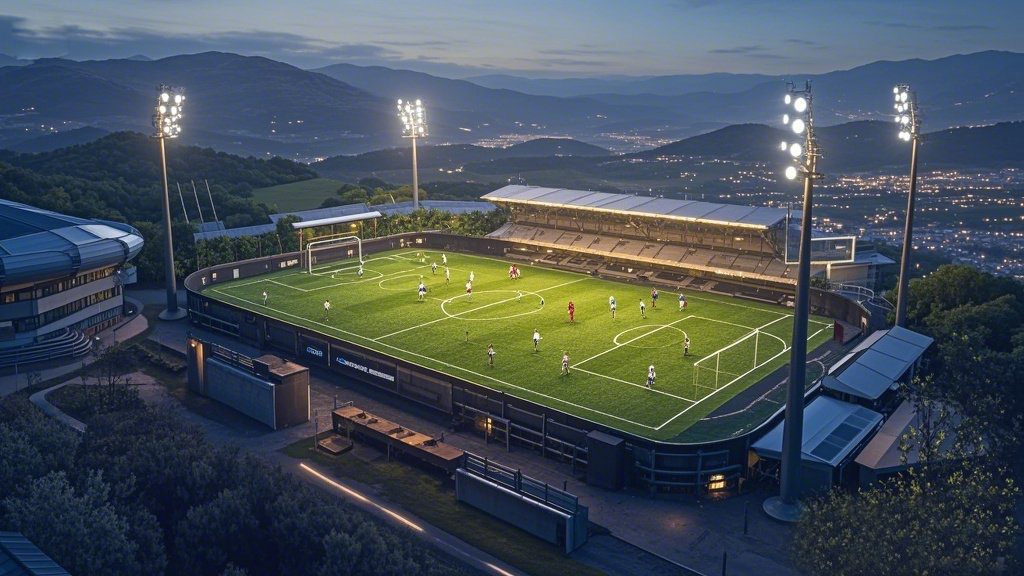
A comprehensive case study of the design, manufacture and installation of LED pitch floodlights
Project Overview
In 2024, our company was selected to provide a complete outdoor lighting solution for a large infrastructure project in Queensland, Australia. The project aims to illuminate the entire football field, providing better visibility and safety for the team. Considering the extreme climatic conditions and high demands for durability and performance, we designed, manufactured and installed cutting-edge stadium floodlights to achieve energy efficiency, environmental sustainability and long-term reliability.
Project Challenges
1. Extreme Weather Conditions
Tropical storms and cyclones: Queensland is located in the north of Australia, which makes it frequently affected by tropical storms and cyclones, especially during the tropical cyclone season between November and April. Tropical cyclones can bring strong winds, heavy rains and flooding, causing serious damage to coastal areas.
Floods: Parts of Queensland, especially in and around Brisbane, often experience flooding after heavy rainfall. Queensland has a long history of flooding, and severe flooding events can lead to large areas of homes being flooded and infrastructure being damaged.
Extreme heat: Inland areas of Queensland, especially in the west and north, often experience extreme heat in summer. Temperatures can reach over 40°C, which poses great challenges to agriculture and water management.
Drought: Although coastal areas of Queensland receive more rainfall, inland and some rural areas often experience drought. Prolonged droughts can lead to water shortages, crop failures, and wildfires.
Wildfires: Queensland’s dry season, especially in late spring and summer, is prone to wildfires. Strong winds and dry weather can exacerbate the spread of fires, causing large areas of forests and farmland to burn.
2. Energy Efficiency Requirements
Energy-efficient lighting solutions were a top priority. The challenge was to balance performance, light quality and energy savings without compromising lighting levels on the football pitch.
3.Tight schedule
Given the scale of the project, the installation had to be completed within a tight timeframe to minimize disruption to the team’s regular evening training sessions.
Our Solution
To meet the stringent requirements of this project, our team leveraged advanced LED technology, integrated smart features, and durable materials to create a solution that addressed both functional and aesthetic needs. Below is a detailed breakdown of the solution we provided:
1. High-Performance LED Lighting
Our LED stadium floodlights use the latest high-efficiency chips (such as SMD3030 and SMD5050) with high brightness and low energy consumption. We select LEDs with a color rendering index (CRI) of over 80 for better color clarity visibility, ensuring better visibility and safety.
2.Weather-Resistant Materials
For maximum durability, the stadium floodlight housing is made of high-grade aluminum alloy with an anti-corrosion surface treatment. This ensures that the stadium floodlight can withstand the harsh effects of extreme heat and sand storms. We also use specialized seals and gaskets to prevent dust and sand from entering the light.
3.Aesthetic Design
The stadium floodlights are sleek, modern in design and blend in perfectly with the football field landscape. Featuring elegant, simple curves, these lights are equipped with energy-efficient optics that direct light exactly where it’s needed without excessive spill or glare.
Production Process
The manufacturing process for this project involved several key stages, all aimed at ensuring the highest standards of quality, performance, and durability:
1. Raw Material Selection
We start by sourcing high-quality raw materials. We chose aviation-grade aluminum, which has excellent heat dissipation performance and long-term durability. The LED chips are selected based on their efficiency and lifespan, ensuring they can withstand high operating temperatures and long-term use.
2.Design and Prototyping
The design phase involved developing a 3D model of the luminaire and running simulations to test its performance under different lighting conditions. Prototypes were manufactured and tested under controlled conditions to ensure they could cope with Queensland’s extreme environmental factors, including high temperatures and severe exposure to windblown sand.
3. Quality Control and Testing
Each batch of LED lights undergoes rigorous testing, including thermal testing, electrical testing, and durability testing. Each light is also tested for water resistance (IP66 rating) and sand resistance, ensuring that the light maintains its performance even in the most extreme conditions.
4. Final Assembly
The final assembly process includes integrating the LED chip, power supply and housing. Each unit then goes through a final inspection and testing phase to ensure it meets all specifications for the project.
Installation Process
1. Site Assessment
Before we began installation, our engineers conducted a comprehensive on-site assessment to determine the best location for each court floodlight. We took into account factors such as court layout, surrounding environment, etc. to ensure maximum coverage and efficiency.
2. Foundation Preparation
Strong concrete foundations were poured to support the light poles, ensuring that they could withstand high winds and the weight of the lighting units. Reinforced steel bars were used for added stability.
3. Light Pole Installation
Each 10 to 12 meter high steel pole was delivered to the site and securely installed. The poles were aligned to provide optimal coverage of the court.
4. Electrical and Wiring Setup
The line floodlights are carefully arranged and connected to a central control system. Each stadium floodlight is equipped with a power supply unit capable of handling high-efficiency LEDs and providing long-term reliable performance.
5. Final Testing
After installation, the entire system is tested to ensure that each luminaire is functioning properly and that the smart features are operational.
Project Outcome and Benefits
The project was successfully completed ahead of schedule and has already begun delivering significant benefits to Queensland. Some of the key outcomes include:
Energy savings: Reducing energy consumption by more than 30%, significantly reducing operating costs.
Reduced maintenance costs: The long life and weather-resistant design of the luminaires reduces maintenance requirements and reduces costs over time.
Enhanced safety: The improved visibility provides better visibility and safety, contributing to a safer nighttime environment.
Sustainability: The project aligns with Queensland’s sustainable development goals by reducing its carbon footprint and supporting smart city initiatives.
Final project image placeholder (completed project)
© 2024 SIRO Light. All rights reserved.
